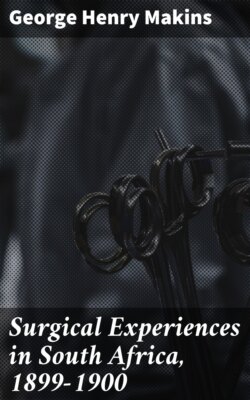Читать книгу Surgical Experiences in South Africa, 1899-1900 - George Henry Makins - Страница 12
На сайте Литреса книга снята с продажи.
General Consideration of the Number of Men Killed and Wounded
ОглавлениеTable of Contents
I will now pass to the question of the proportionate frequency with which the men were killed or wounded during the present campaign. I propose to take only one series of battles, with which I was personally acquainted throughout, to illustrate this point. This seems the more satisfactory course to follow, since the number of casualties is still undergoing continuous gradual increase, and besides this the warfare has assumed a peculiar and irregular form, statistics from which scarcely possess general application.
The battles included, those of the first Kimberley Relief Force, were fought under fair average conditions as to the nature of the ground. In the first two the defending enemy occupied heights, in the two following the ground advanced over by our men was comparatively even; thus at Modder River there was only a gradual slope upwards, and at Magersfontein the advanced trenches of the Boers were only slightly above the level of the ground over which the advance was made. At the same time, at the latter battle a great number of the Boers engaged were on the sides of the hill well above the advanced trenches. In no case were the Boers in such a position as to have to fire upwards, to them a considerable advantage. It must also be noted that throughout the Boers were able to rest their rifles; hence the fire should have been at any rate of an average degree of accuracy. In the advances of our own men, anthills and stones were practically the only cover to be obtained, and little or no help was given by variations in the general surface. All these points seem to favour a large proportional number of hits on the part of the riflemen. I very much regret that I am unable to say what was the proportional number of shell wounds among the men hit, but I can say with some confidence that among the wounded it was not as great as ten per cent. I should be inclined to place it as low as five per cent. Again, I cannot fix the proportionate occurrence of wounds from bullets of large calibre such as the Martini-Henry, but this was certainly not large. I think if ten per cent. is deducted to represent the number of hits from either of these forms of projectile, that we may fairly assume the remaining 90 per cent. of the wounds to have been produced by bullets of small calibre. The numbers of the opposing forces were probably fairly even.
Taking all these circumstances together, and bearing in mind that our army was always in the position of having to make frontal attacks on men well protected in strong positions, I think it must be allowed that a fair idea should be possible of the effectiveness of the modern weapons. Only one circumstance, one inseparable from any fighting with the Boers, seems to affect the numbers in an important manner. This consists in the fact that the Boer rarely fights to the bitter end, hence the greater proportion of his hits are obtained at long distances.
